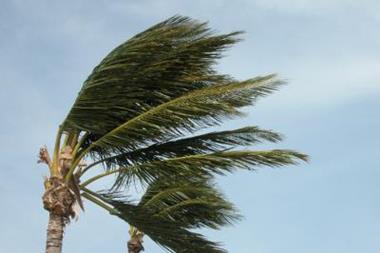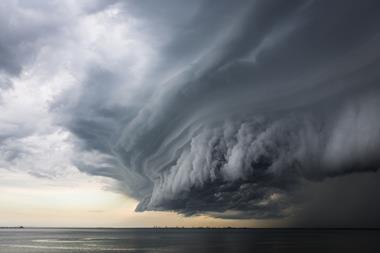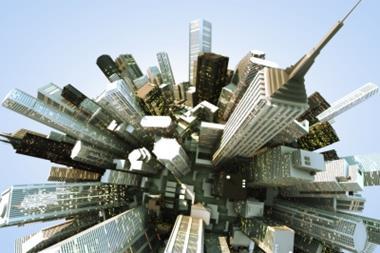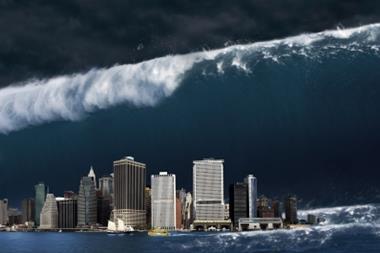The hurricanes striking land in the US in 2004 and 2005 have provided a wealth of experience on commercial building writes Timothy Reinhold
The hurricanes striking land in the United States and Mexico during 2004 and 2005 have provided a wealth of experience on the performance of commercial buildings at various levels of wind action. By Timothy Reinhold
Global structural failures of buildings with heavy structural systems were quite rare during the two hurricane seasons, with the exception of a few dramatic failures of slab on grade multi-storey buildings that pancaked after surge-related waves knocked out load bearing walls at lower levels and the partial collapse of a large arena during Hurricane Charley in 2004.
Instead, building envelope failures and water intrusion issues were responsible for the larger than expected losses to commercial structures. Such damage can result in prolonged loss of use and consequently large business interruption losses.
The 2004 hurricane season produced four storms of particular interest with respect to the performance of commercial buildings: hurricanes Ivan, Charley, Frances and Jeanne. Hurricane Charley was the strongest wind event to hit the US mainland since Hurricane Andrew in 1992. The Florida cities of Punta Gorda and Port Charlotte experienced gust wind speeds in the 150mph (241kph) range, which was about 15 to 20% above the design wind speeds, and inland towns and cities through to Orlando got gust winds at or above design level.
Hurricanes Frances and Jeanne exposed broad areas of the east coast of Florida to high winds for a significant period of time. Much of the area affected was the same for both storms. While the wind speeds were below design levels, Frances and Jeanne afforded the opportunity to observe the performance of buildings subjected to elevated winds in multiple events.
Hurricane Ivan subjected the coastal areas of Florida and Alabama to strong Category 1 or weak Category 2 winds - design level winds when compared to the older Standard Building Code norms that were used for much of the inventory in that area. However, in terms of the newer International Building Code and Florida Building Code 2001, Ivan's winds were below design level for most of the area of impact. By contrast, the storm surge Ivan generated was more typical of a Category 4 event.
For the 2005 hurricane season, there were four storms that produced opportunities for study and assessment, but this article focuses on hurricanes Katrina and Wilma. Katrina produced the lowest central pressure measured for a storm in the Gulf of Mexico, and while the wind field spread out and wind speeds diminished before landfall, the storm surge was by far the highest recorded along the Gulf Coast. The strongest wind speeds along the Gulf Coast of Mississippi were close to design levels for the newer International Building Code, although in the New Orleans area, they were below design level.
In October, Hurricane Wilma pounded Cancun and the Mexican coast with wind gusts estimated near 150mph (241kph) and impacted a broad area across the southern tip of Florida with gust wind speeds measured between 100 and 110mph (161-177kph).
Key observations
Multi-storey buildings with robust structural systems (steel or concrete frames) appear to have come through these events with little structural distress. The few large multi-storey buildings that did collapse in Hurricane Ivan had load bearing walls at the lower levels that were wiped out by storm surge.
As structural systems get lighter and roof spans become longer, commercial buildings are more likely to get into trouble, and failures of components and cladding elements can lead to partial or complete collapse. However, the most common damage to commercial buildings is to the building envelope: the wall coverings, wall systems, windows, doors and the roof systems that make up the weather barrier.
Penthouse enclosures
A frequent failure point that showed up in a number of the storms was damage to penthouse enclosures on the roofs of multi-storey buildings as illustrated in Image 1. When the penthouse encloses the mechanical equipment for elevators and there is loss of siding or roofing, water intrusion can lead to failure of the elevator system that can affect the operation of the building for weeks after the event. Several hospitals lost elevator function in this way.
Wall cladding systems
Failures of wall cladding systems including stone veneers, metal panels and especially windows and exterior insulating finishing system (EIFS) wall coverings led to extensive water intrusion, damage to interior partitions, ceilings and extended loss of use of many buildings.
Windows and doors
It is clear that adequate pressure rating of wall and window systems is necessary, but this is not sufficient to prevent damage and loss. Where the codes are followed and walls and windows are intact after the storm, we still frequently see damage and losses from water intrusion. There were pressure induced failures of windows and sliding glass doors protected by shutter systems.
In some cases, the failures were traced to installation issues; others were probably due to the presence of products that had inadequate pressure ratings for the application. The specification and installation of pressure-rated products has significantly improved in recent years as newer codes have been adopted and attention to the pressure requirements has improved.
As structures become more resistant to wind induced failures, water intrusion around windows and doors is becoming a bigger factor resulting in continued damage and loss. Some hotel rooms in Cancun filled up with five or more inches of water although the doors and windows remained in place.
Current test standards for water leakage only require that windows and doors keep water out at a small fraction of the design wind pressure. Consequently, in any event approaching about half of the design wind speed (one-quarter of the design pressure), there is a very high probability that the windows and doors will leak. Sometimes the water leaks into the interior of the building and sometimes into the wall cavity where it can lead to decay of the wall anchorage system, damage to wall surfaces, or the growth of mould.
Exterior finishing
Water leakage into wall cavities of buildings with EIFS is a particular problem for commercial buildings. Most of the EIFS being installed on commercial buildings does not appear to provide adequate drainage planes and drainage. A number of hotels along the Atlantic coast of Florida that were well north of the high wind impact areas from Hurricanes Frances and Jeanne nevertheless required extensive repairs to their exterior and interior wall surfaces and suffered extended loss of use, although the wind gusts they experienced were probably less than 70% of design winds for the area. Image 2 shows a typical EIFS wall failure on a building that suffered winds which were probably below design levels.
Overhead doors
Failure of overhead doors on commercial buildings remains too common. This failure frequently leads to substantial loss of cladding from wall and roof systems as shown in Image 3.
Furthermore, there were reports of light metal roof system failures in Hurricane Jeanne for buildings that appeared to weather Hurricane Frances without too much distress. It is likely that the high loads imposed by Frances weakened the metal around the fasteners, and the accumulation of damage (fatigue) from the repeated high uplift loads over the course of the two storms caused the panels to give way.
This type of damage was widespread when Cyclone Tracy struck Darwin, Australia in 1974 and it led to changes in fasteners. The recent failures suggest that the fatigue loading issue for metal panels needs to be revisited.
Roofing systems
Failures of roofing systems for commercial buildings are frequent and the associated water intrusion can be very costly. Many of the post-storm investigations have suggested that flashing failures and inadequate anchorage, particularly around the edges of the roofs, were to blame. There are strong indications that the type of roofing inspection and remedial measures some commercial insurers require are paying significant dividends in terms of lower losses.
Debris
The tremendous amount of broken glass in Cancun and in South Florida from Hurricane Wilma and in New Orleans from Katrina suggests that pressure related failures of glass are still more common than they should be, but that flying debris is an even bigger issue. Failures of glass in buildings built after South Florida began to require that windows on high rise buildings be able to resist the impact of small missiles suggest that the present test is inadequate for the types of debris that clearly blow around urban areas in even relatively weak hurricanes.
Conclusions
While structural failures are fairly infrequent for major commercial buildings, structural failure in light commercial buildings continues to be an issue. Changes in design requirements that eliminate the time honored practice of reducing capacity by 33% for wind loads (one-third allowable stress increase) should result in somewhat more robust structural systems on light commercial buildings. Nevertheless, as the weight of the structural system and cladding diminishes in relation to the magnitude of the wind loading, the design of both members and the connections becomes more critical.
Much work remains to be done to ensure that building envelopes perform well in hurricanes, and that water intrusion is kept to a manageable level so that losses and interruption of use are limited.
Test standards for small missile, windborne debris impact need to be revisited and potential sources of debris in urban areas controlled as much as possible.
In terms of water intrusion and management of the water that does penetrate the building, test methods need to be revised and design requirements need careful attention in hurricane prone regions.
Cost effective remedial measures for existing buildings should be developed. Effective loss control programmes for hurricane-prone regions are likely to require inspections of properties coupled with carefully developed, practical remediation schemes.
Timothy Reinhold is director of engineering for the Institute for Business & Home Safety (IBHS) in Tampa, Florida. The IBHS is a non-profit association supported by the insurance industry and works to reduce the social and economic effects of natural disasters and other property losses.
treinhold@ibhs.org
www.ibhs.org



















